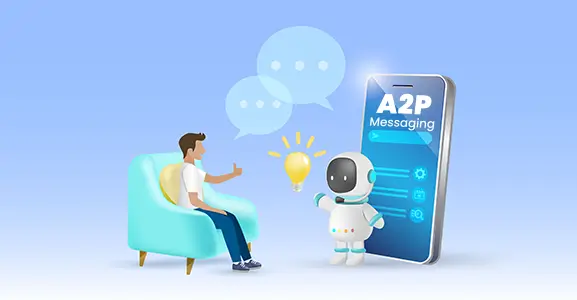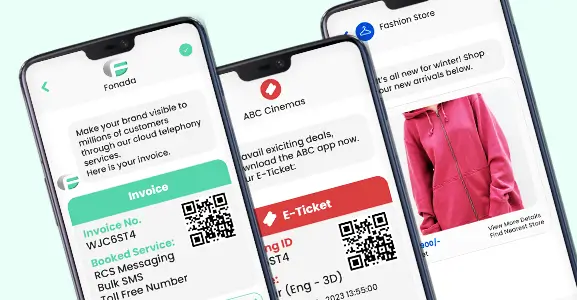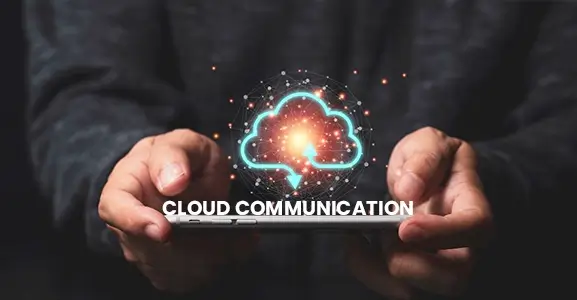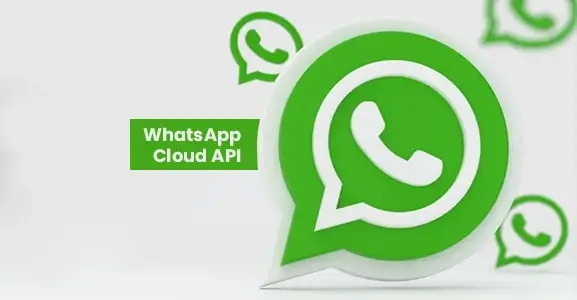Application-to-person messaging is becoming a popular way for businesses to communicate with customers, clients, and employees—and for good reason. SMS or MMS text messaging tends to get much better response rates. (According to Gartner, “SMS open and response rates [are] as high as 98% and 45%, respectively — in contrast to corresponding figures of 20% and 6% for email.”)
Whether you’re a business owner thinking of new ways to contact potential clients en masse or a marketer interested in sending SMS marketing messages for your next campaign, this guide will cover everything you need to know, from how A2P messaging works to creative use case ideas.
What Is Application To Person (A2P) Messaging?
Application-to-Person messaging (A2P) refers to the communication flow where individuals receive messages from applications rather than other human users, and these messages typically do not necessitate a response. Examples of A2P messages encompass a broad range, including marketing communications, appointment reminders, chat bots, notifications, and one-time passwords (OTPs) or PIN codes.
Types Of A2P Messaging
1. Transactional Messaging
- Description: Messages sent as part of a transaction between a user and an application. These are often critical, time-sensitive communications such as account alerts, purchase confirmations, and delivery notifications.
- Use Cases: Order confirmations, appointment reminders, account balance alerts.
2. Promotional Messaging
- Description: Marketing or promotional messages sent by businesses to a large audience. These messages aim to promote products, services, or special offers.
- Use Cases: Marketing campaigns, promotional offers, product launches.
3. Alerts And Notifications
- Description: Informational messages that notify users about important events or updates. These can include emergency alerts, system notifications, and service updates.
- Use Cases: Emergency alerts, system downtime notifications, service updates.
4. One-Time Passwords (OTPs) And Verification Codes
- Description: Messages containing temporary codes used for user authentication and verification. These are crucial for securing online accounts and transactions.
- Use Cases: Two-factor authentication, account verification, secure login.
5. Appointment Reminders
- Description: Messages sent to remind users of scheduled appointments, meetings, or events. These can reduce no-shows and improve overall scheduling efficiency.
- Use Cases: Doctor appointments, salon bookings, meeting reminders.
6. Surveys And Feedback Requests
- Description: Messages used to gather feedback from users about their experiences with a product, service, or interaction.
- Use Cases: Customer satisfaction surveys, product feedback requests.
7. Interactive Messaging:
- Description: Messages that encourage users to interact by responding with specific actions or choices. This can include voting in polls, participating in contests, or providing feedback.
- Use Cases: Polls, contests, feedback collection.
8. Order Status And Shipment Tracking:
- Description: Messages that keep users informed about the status of their orders, including order confirmations, shipping updates, and delivery notifications.
- Use Cases: E-commerce order updates, package tracking.
9. Customer Support And Chatbots:
- Description: Messages that facilitate customer support interactions. A2P messaging can be integrated with chatbots to provide automated responses and assistance.
- Use Cases: Automated customer support, FAQ responses, issue resolution.
10. Educational And Informational Messages:
- Description: Messages that deliver educational content, updates, or important information to users.
- Use Cases: Training updates, informational announcements, educational content delivery.
These types of A2P messaging cover a broad spectrum of communication needs, allowing businesses and applications to engage with users in a diverse and effective manner.
Top 10 Benefits Of A2P (Application-To-Person) Messaging
1. High Engagement Rates: A2P messaging boasts significantly higher open and response rates compared to other communication channels. With open rates reaching as high as 98%, businesses can ensure that their messages are more likely to be read promptly.
2. Reliability and Timeliness: A2P messages are delivered instantly, providing businesses with a reliable and timely means of communication. This is especially crucial for time-sensitive information, such as appointment reminders or one-time passwords (OTPs).
3. Wide Reach: A2P messaging allows businesses to connect with a vast audience simultaneously. Whether sending marketing communications, notifications, or important updates, A2P messaging enables mass outreach in an efficient manner.
4. Cost-Effective Communication: Compared to traditional methods, A2P messaging is often more cost-effective. Businesses can save on expenses related to paper, postage, and other resources, making it a budget-friendly option for large-scale communication.
5. Enhanced Customer Experience: A2P messaging facilitates personalized and interactive communication. Businesses can engage with customers through tailored messages, leading to an improved overall customer experience.
6. Versatility in Use Cases: A2P messaging supports a wide range of use cases, including marketing promotions, appointment scheduling, account notifications, and more. Its versatility makes it a valuable tool for various industries and business functions.
7. Security and Authentication: A2P messaging is commonly used for sending secure information, such as one-time passwords (OTPs) or PIN codes. This enhances security measures for authentication purposes, ensuring that sensitive data reaches the intended recipient securely.
8. Automation and Efficiency: A2P messaging can be integrated with automated systems, streamlining communication processes. This automation not only saves time but also ensures that messages are delivered consistently and accurately.
9. Compliance and Regulations: A2P messaging platforms often adhere to industry regulations and compliance standards. This ensures that businesses can communicate with their audience while maintaining legal and ethical standards, particularly in areas such as data protection and privacy.
10. Scalability: A2P messaging solutions are scalable to accommodate the growing needs of businesses. Whether reaching out to a small local audience or a global customer base, A2P messaging can scale accordingly to meet demand.
Use Cases Of A2P (Application To Person) Messaging
A2P messaging has various use cases for a business, here are our top picks-
- Authentication and Verification: A2P messaging is commonly employed for two-factor authentication, password reset, and user account verification. Users receive one-time passwords (OTPs) or verification codes via A2P messages to enhance account security.
- Appointment Reminders: Healthcare providers, salons, and service-oriented businesses use A2P messaging to send appointment reminders to clients, reducing no-shows and improving overall appointment management.
- Marketing Campaigns: Businesses leverage A2P messaging for promotional campaigns, sending targeted offers, discounts, and product announcements to a wide audience. The high open rates of A2P messages contribute to the success of marketing initiatives.
- Transaction Alerts: Financial institutions use A2P messaging to notify customers of transactions, account balances, and other financial activities. These alerts help users stay informed about their accounts in real-time.
- Order Confirmations and Updates: E-commerce platforms use A2P messaging to confirm orders, provide shipment tracking information, and update customers about the status of their purchases.
- Emergency Alerts and Notifications: Government agencies and organizations use A2P messaging for emergency alerts, such as natural disasters, public safety announcements, and other critical information that requires immediate dissemination.
- Surveys and Feedback Collection: Businesses seeking customer feedback or conducting surveys can use A2P messaging to reach a large audience. Users can respond to prompts and provide feedback, helping companies gather valuable insights.
- Educational Updates: Educational institutions utilize A2P messaging to communicate with students and parents, sending updates on school events, exam schedules, and important announcements.
- Customer Support and Chatbots: A2P messaging is integrated into customer support systems to provide automated responses, answer frequently asked questions, and assist users with common queries. This improves the efficiency of customer service.
- Interactive Contests and Polls: Brands and organizations engage with their audience by running interactive contests, polls, and surveys through A2P messaging. Users can participate by responding to messages, fostering interaction and brand engagement.
- Subscription Alerts: Users can subscribe to receive alerts and updates about specific topics, products, or services through A2P messaging. This is commonly used in news services, sports updates, and content subscriptions.
- Employee Communication: Businesses use A2P messaging for internal communication with employees. This includes sending updates on company policies, HR announcements, and important news.
- Travel Updates: Airlines, hotels, and travel agencies use A2P messaging to provide travelers with updates on flight status, reservation confirmations, and other travel-related information.
Top 11 A2P (Application To Person) Messaging Challenges
While A2P (Application-to-Person) Messaging offers numerous benefits, it also comes with several challenges. Some of the key challenges include:
- Spam and Fraud: The prevalence of spam and fraudulent activities can diminish the trustworthiness of A2P messaging. Unsolicited messages or scams can lead to user frustration and erode the effectiveness of legitimate A2P communications.
- Message Delivery Issues: A2P messages may face delivery challenges, including delays or non-delivery. Issues such as network congestion, routing problems, or carrier restrictions can impact the reliability of message delivery.
- Regulatory Compliance: A2P messaging is subject to various regulations and compliance standards, which vary across regions. Adhering to these regulations, such as obtaining consent for messaging and respecting user preferences, can be complex and requires ongoing efforts.
- Security Concerns: A2P messages containing sensitive information, such as one-time passwords (OTPs) or transaction confirmations, may be susceptible to interception or unauthorized access. Ensuring the security and privacy of such messages is a critical concern.
- User Opt-Out Challenges: Providing users with the option to opt out of A2P messages is a regulatory requirement in many regions. Managing opt-out requests effectively and promptly can be challenging, and non-compliance can result in penalties.
- Number Spoofing and SIM Farms: Malicious actors may engage in number spoofing, making it appear as though messages are coming from a legitimate source. SIM farms, which use multiple SIM cards to send large volumes of messages, can also be used for fraudulent purposes.
- Interoperability: A lack of standardization and interoperability among different A2P messaging platforms and networks can create challenges for seamless communication. Ensuring compatibility across diverse systems is crucial for effective message delivery.
- Technological Limitations: Some A2P messaging platforms may face limitations in terms of message length, multimedia support, and formatting. These limitations can impact the ability to convey complex information or engage users with multimedia content.
- Costs and Revenue Assurance: Managing the costs associated with A2P messaging, including carrier fees and infrastructure investments, can be complex. Businesses must also ensure that they are receiving accurate revenue shares when partnering with messaging aggregators and carriers.
- Rise of OTT Messaging Apps: Over-the-Top (OTT) messaging apps, such as WhatsApp and Telegram, have gained popularity for communication. The increasing use of these apps can divert user attention away from traditional A2P SMS messaging, impacting its effectiveness.
- Global Variability: A2P messaging faces different challenges in different regions due to varying regulations, cultural norms, and technology infrastructures. Adapting strategies to address regional nuances can be demanding.
Addressing these challenges requires a combination of technological solutions, industry collaboration, and adherence to regulatory frameworks. As A2P messaging continues to evolve, stakeholders must work together to overcome these obstacles and ensure the continued effectiveness and reliability of this communication channel.
Top 5 A2P (Application To Person) Messaging Providers
- Fonada is an A2P messaging provider that enables your company to send notifications, reminders, and even promotional messages to your customers via any application. The simple SMS API allows developers to quickly add SMS functionality to enterprise apps, allowing you to reach out to customers in the most convenient way possible.
- Infobip is the best digital communication company in the world. It offers a full-stack Communications Platform and zero-hop connections to global telecommunications. The company helps organizations globally connect, engage, and satisfy customers.
- SAP is a well-known company that makes business resource planning software. It builds systems that make it easy for organizations to process data and share information. Businesses can improve complex business processes by providing real-time information to employees across departments.
- Sinch, formerly CLX Communications, provides cloud communications, A2P SMS, and telephone services. It uses sign-ups and logins that are easy and safe to protect companies, improve the user experience, and boost conversion rates.
- Tata Communications is a digital ecosystem that helps organisations reach their full potential by enabling borderless expansion, boosting product development and customer experience, productivity and efficiency, agility, and risk management. Tata Communications powers the next level of intelligence driven by cloud, mobile, IoT, collaboration, privacy, and network services.
FAQs
A2P (Application-to-Person) messaging is a communication method where applications send messages to individuals. This includes various types of messages such as transactional alerts, marketing promotions, notifications, and more.
A2P messaging involves applications using an SMS or MMS channel to send messages to end-users. These messages are typically automated and can include transactional updates, marketing content, and other information.
Common A2P messaging use cases include transactional messages (e.g., account alerts), marketing promotions, appointment reminders, authentication messages (e.g., one-time passwords), and customer support interactions.
A2P messaging involves communication between an application and an individual, while P2P messaging is direct communication between individuals. A2P messages are often automated and not expected to receive a reply.
A2P messaging offers advantages such as high engagement rates, timely communication, cost-effectiveness, wide reach, and versatility in use cases. It is particularly effective for transactional alerts and marketing communications.
Ensuring A2P message deliverability involves complying with regulations, obtaining user consent, using reputable messaging gateways, optimizing message content, and monitoring for potential issues like spam.
Yes, A2P messaging is subject to various regulations, including data protection and privacy laws. Businesses must obtain user consent, provide opt-out options, and adhere to regional regulations governing messaging practices.
Two-factor authentication adds an extra layer of security by requiring users to provide a second form of verification, often delivered through A2P messages. This helps protect user accounts from unauthorized access.
Businesses can protect against A2P messaging fraud by implementing security measures such as message encryption, monitoring for unusual activity, and working with reputable messaging providers to detect and prevent fraudulent activities.
A2P messaging plays a crucial role in customer engagement by enabling businesses to send personalized promotions, transactional updates, appointment reminders, and other relevant information directly to users. It fosters timely and interactive communication, enhancing the overall customer experience.

Dec 11, 2024
Top Contact Center Optimization Tools For 2024
“A thriving business knows how to fetch maximum output from limited resources by optimizing ca... Read More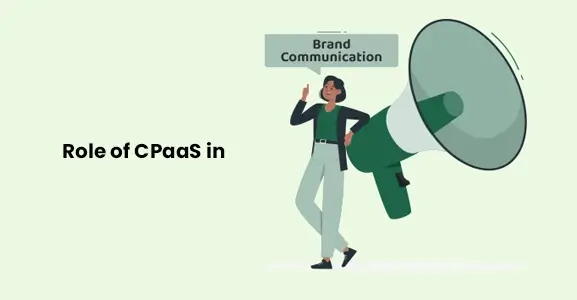
Nov 13, 2024
What Is Brand Communication? CPaaS Role Explained
Did you ever wonder why some advertisements grab your attention instantly, while others do not? The... Read More
Nov 01, 2024
What Is Automated Messaging And How Does It Work?
Automated messaging or text automation empowers businesses and marketing professionals to connect wi... Read MoreLatest Updates
From Fonada
Industry Insights, Trends, Innovations, Updates, and Case Studies from Industry Experts
View
Customer
Reviews
Discover why our customers love us - read their authentic and heartfelt reviews!
View
Case
Studies
Explore real-life scenarios, offering analysis, and solutions to practical challenges
View
Convert Leads Into Sales With Fonada
Trusted CPaaS Solution Provider

